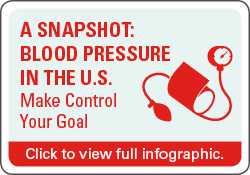High Blood Pressure Facts
Learn more about high blood pressure and its risk factors. It is important for everyone to know the facts about high blood pressure [PDF-255K].
High Blood Pressure in the United States
- About 75 million American adults (29%) have high blood pressure—that’s 1 of every 3 adults.1
- Only about half (54%) of people with high blood pressure have their condition under control.1
- Nearly 1 of 3 American adults has prehypertension—blood pressure numbers that are higher than normal, but not yet in the high blood pressure range.1
- High blood pressure costs the nation $46 billion each year. This total includes the cost of health care services, medications to treat high blood pressure, and missed days of work.2
Blood Pressure Levels Vary by Age
Women are about as likely as men to develop high blood pressure during their lifetimes. However, for people younger than 45 years old, the condition affects more men than women. For people 65 years old or older, high blood pressure affects more women than men.2
| Age | Men (%) | Women (%) |
|---|---|---|
| 20-34 | 11.1 | 6.8 |
| 35-44 | 25.1 | 19.0 |
| 45-54 | 37.1 | 35.2 |
| 55-64 | 54.0 | 53.3 |
| 65-74 | 64.0 | 69.3 |
| 75 and older | 66.7 | 78.5 |
| All | 34.1 | 32.7 |
Blood Pressure Levels Vary by Race and Ethnicity
Blacks develop high blood pressure more often, and at an earlier age, than whites and Hispanics do. More black women than men have high blood pressure.2
| Race of Ethnic Group | Men (%) | Women (%) |
|---|---|---|
| African Americans | 43.0 | 45.7 |
| Mexican Americans | 27.8 | 28.9 |
| Whites | 33.9 | 31.3 |
| All | 34.1 | 32.7 |
Why Blood Pressure Matters

View this graphic snapshot of blood pressure in the United States for more information on how high blood pressure affects us.
More than 360,000 American deaths in 2013 included high blood pressure as a primary or contributing cause.2 That is almost 1,000 deaths each day.
High blood pressure increases your risk for dangerous health conditions:
- First heart attack: About 7 of every 10 people having their first heart attack have high blood pressure.2
- First stroke: About 8 of every 10 people having their first stroke have high blood pressure.2
- Chronic (long lasting) heart failure: About 7 of every 10 people with chronic heart failure have high blood pressure.2
- Kidney disease is also a major risk factor for high blood pressure.
Although you cannot control all of your risk factors for high blood pressure, you can take steps to prevent or control high blood pressure and its complications.
Top of PageTalk with Your Health Care Team About Blood Pressure
- Since 1999, more people with high blood pressure—especially those 60 years old or older—have become aware of their condition and gotten treatment. Unfortunately, about 1 of 5 U.S. adults with high blood pressure still do not know that they have it.2
- About 7 in 10 U.S. adults with high blood pressure use medications to treat the condition.1
- In 2009, Americans visited their health care providers more than 55 million times to treat high blood pressure.2
- Using team-based care that includes the patient, primary care provider, and other health care providers is a recommended strategy to reduce and control blood pressure.5
Reducing the average amount of salt or sodium that people eat from 3,400 milligrams (mg) to 2,300 mg per day—the level recommended in the Dietary Guidelines for Americans, 2010—may reduce cases of high blood pressure by 11 million and save 18 billion health care dollars every year.4
CDC Fact Sheets Related to High Blood Pressure
- High Blood Pressure
- Pulmonary Hypertension
- Heart Disease
- Signs and Symptoms of a Heart Attack
- Stroke
- Signs and Symptoms of Stroke
- High Cholesterol
References
- Merai R, Siegel C, Rakotz M, Basch P, Wright J, Wong B; DHSc., Thorpe P. CDC Grand Rounds: A Public Health Approach to Detect and Control Hypertension. MMWR Morb Mortal Wkly Rep. 2016 Nov 18;65(45):1261-1264
- Mozzafarian D, Benjamin EJ, Go AS, et al. Heart Disease and Stroke Statistics-2015 Update: a report from the American Heart Association. Circulation. 2015;e29-322.
- Heidenreich PA, Trogdon JG, Khavjou OA, et al. Forecasting the future of cardiovascular disease in the United States: a policy statement from the American Heart Association. Circulation. 2011;123:933–44.
- Palar K, Sturm R. Potential societal savings from reduced sodium consumption in the U.S. adult population. Am J Health Promot. 2009;24:49–57.
- Guide to Community Preventive Services. Cardiovascular disease prevention and control: team-based care to improve blood pressure control.
- Page last reviewed: November 30, 2016
- Page last updated: November 30, 2016
- Content source:



 ShareCompartir
ShareCompartir